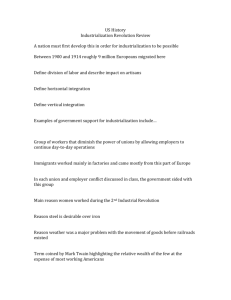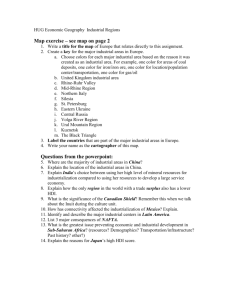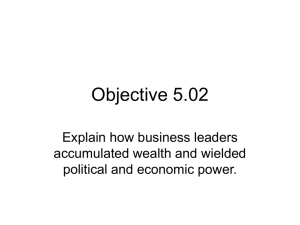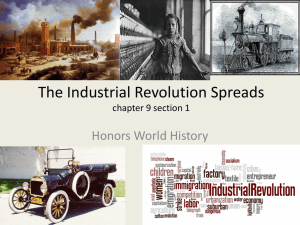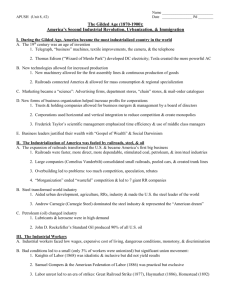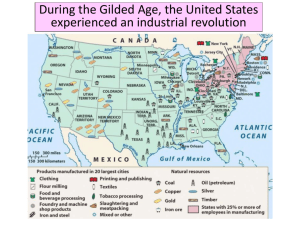Labor Movement
advertisement
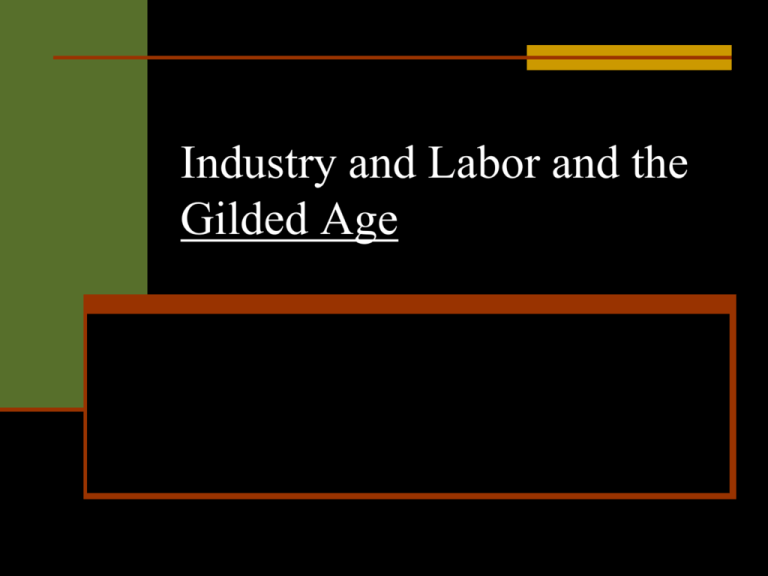
Industry and Labor and the Gilded Age Why do they call it the Gilded Age? The term Gilded Age refers to the political and economic situation 1876 to 1900. The term "Gilded Age" was coined by Mark Twain A period of ruthless profit, government corruption, mass consumption, and vulgarity in taste and manners. Historians Comment (Charles and Mary Beard) “With a stride that astonished statisticians, the conquering hosts of business enterprise swept over the continent; 25 years after the death of Lincoln, America had become, in the quantity and value of her production, the first manufacturing nation of the world. What England accomplished in a hundred years, the United States had achieved in half the time.” What is the Industrial Revolution about? = The Transformation Production of the US national Transportation Economy Immigration Rise of Cities Decline in pop from rural areas Corruption Union Activism Racism/Nativism When does the Industrial Revolution take place? Various periods of American History 1st Industrial Revolution 1800-1860 begins in early 1800’s with textile manufacturing and iron production 2nd IR really takes off in the latter part of 1800’s, ca 1870-1915 The development of factory production has consequences for virtually every portion of society. Industrialization brings positives effects: Inventions are created-More products--produced faster-- produced cheaper Jobs are created--- people have money to buy more goods-economy gets better for everyone Rich people get richer-- create more factories or businesses -- create more jobs--economy gets better for everyone Immigration-when jobs are available-------people move to the location of jobs-industrialization causes immigration-- Factories are built where people live-------cities grow The development of factory production has consequences for virtually every portion of society. Industrialization brings negative effects: Industrialization causes--pollution-air, water Industrialization causes---poverty- government doesn’t protect workers at first- workers compete with other workers for low skill jobs- workers work long hours- get low pay- unsafe working conditions Poverty is so bad-children need to work Massive wealth is created by factory owners- causes corruption- business owners use money to influence government officials Changes due to Industrialization Technology: New products and inventions consumer and business Business Organizations: Corporation, Trusts Cities Grow: rural to urban migration and immigration, c Labor Protections: unions, working conditions, benefits, safety Sources of Industrial Growth 1. Raw materials 2. Large Labor Supply 3. Technological Innovation 4. Entrepreneurs 5. Federal Gov = eager to support business 6. Domestic Markets for goods 7. Business Organization Iron and Steel 1870-1880s Iron Production soared Then Steel= 40,000 miles of track Aided by the Bessemer Process Blowing air and secret ingredients through molten iron to burn out impurities Blast Furnace Open Hearth Furnace I Beam allowed sky scrappers New Furnaces 500 tons per week Western Pennsylvania, Pittsburgh, Steel towns- Cleveland, Detroit, Chicago, Birmigham Michigan, Minnesota, Birmingham AL (Iron Ore) Rail Roads: B and O, Pennsylvania, Reading, Short Line, Southern Pacific, Central Pacific Railroad Industry spurs development Iron for Engines, and rails, later steel Farms, lumber, Buffalo Hunters Employment- Chinese in West, and Irish in East Aids transportation, access to raw materials and markets, spurs construction Land is granted to RR companies in exchange for building the RR- esp Transcontinental RR Later RR will own tremendous amount of land and sell it to people moving WEST By 1880s there are 150,000 miles of Rail creating an national economy. Rail Roads continued Standard Time (4 zones) Growth of Track 1860- 52,000 miles 1870- 93,000 miles 1890- 163,000 miles 1900- 193,000 miles Chicago is a major rail hub Government paid subsidies, $ to RR in order to complete and aid in Western railroad development Railroads Continued Farmers will be angry with RR for price fixing and monopoly Grangers- or farmer groups push state regulations on railroads- these laws are negated by the Interstate Commerce Act 1887, removing any jurisdiction over railroads by states, only the Federal Government can regulate trade between states. Other Industries Oil- begins in Western Pennsylvania Refining, Fuel oil, lamps, kerosene John D. Rockefeller Standard Oil Auto Industry Ford Assembly Line 1895 = 4 automobiles in America 1917= 5 million 1914- 12 ½ hours to make 1 car After 1915- 1 ½ 1 car Prices= 1914- $950 Prices= 1929- $290 •Airplane•Wright Bros •Orville and Wilbur •1903 Kitty Hawk, NC Taylorism= Scientific Management Production process should be Divided into specialized tasks Each task speeds up production Train all workers to do unskilled jobs “Makes workers interchangeable” Increases profits and decreases costs for consumers Free Enterprise: Capitalism “Business and Government don’t mix.” In the United States this statement has been argued for over for many years. Do they Mix? What do you think? Adam Smith: The Wealth of Nations (1776) Laissez-faire Capitalism: “Let it Be” The Market System: Laws of supply and demand determine prices (The Invisible Hand) According to Smith’s ideas: Business should be free of government interference. Smith understood that: Business owners or Entrepreneurs, as a rule, want to make as much money or profit as possible. They don’t want to pay taxes. They want to provide goods or services at the lowest possible price and creating the most profit. According to Smith a Pure Market Economic System would achieve the maximum good for society: Characteristics No government control Freedom of choice Private Property Profit Competition Robber Baron or Captain of Industry? Robber Baron Captain of Industry/Industrial Statesman” Captains of Industry or Robber Barons? John D. Rockefeller Andrew Carnegie (1873) Standard Oil Bought out competition 1881 Standard Oil Trust controlled 90% of oil refinery business Used horizontal integration to ruthlessly control and conquer the Oil industry Jim Fisk and Jay Gould Corrupt business practices Investments Pennsylvania Steel Works Cut costs Made deals with RRs Bought rival copmanies Henry Clay Frick manager Owned coal mines Iron mines Ships Controlled from mine to market Used vertical integration Created Steel trust Very wealthy Carnegie Steel 1901 (sold to J.P. Morgan$450 Million New Business Organization Sole-Proprietorship New Business organization: Corporation- a company sells stock or pieces of ownership in a company, investors buy stock which entitles them to a share in the profit Owners of stock- have limited liability, they are not personally responsible for loses in the business and can not lose more than their investment Companies incorporate to eliminate liability, raise money from sale of stock Spurs the growth of corporations and the middle class Dividend- a return on profits, paid to stock holder Business http://us.history.wisc.edu/hist102/lectures/lecture05.html (Great Web Site) Trust: stockholders in individual corporations transfer stocks to a group of trustees, in exchange for shares in the trust itself Holding Company: trust or corporation that buys stock or owns businesses in other industries, oil refinery owns a railroad. Horizontal Integration: expansion of one corporation or owner takes over other businesses in and industry, example Standard Oilforces out of business other oil companies. Vertical Integration: form of business expansion where one industry controls aspects of the business, raw materials, to the distributor example: Carnegie began with steel mills, then railroads, coal mines, iron mines, and distributor of Sherman Anti-trust Act 1890 1890- Congress passes law that addresses trusts in commerce industry “Every contract or combination in the form of trust or otherwise, or conspiracy, in restraint of trade or commerce” is illegal. Law is weak and applied on a limited basis Progressives will strengthen laws in the early 1900s Gospel of Wealth By Andrew Carnegie People with great wealth have the responsibility to use their riches to advance social progress (moral issues) Carnegie- a self made man, immigrant, later philanthropist, believed in this, “All revenue generated beyond your own needs should be used for the good of the community.” Individualism and Horatio Alger All had in common the idea that great wealth was possible if the individual will work hard enough for it… Social Darwinism Based on the scientific studies of Charles Darwin- Natural Selection Ideas are applied to society and business Only the fittest survived “There is not a poor person in the United States who was not made poor by his own shortcomings.” Gap Between Rich and Poor 10% of population owns 90% of wealth 2/3 of the population were working class, employed by someone else. Included skilled and unskilled workers Skilled workers were paid more Women and children work in factories- Industry and the Workers Working Conditions: Work in these factories was: Dangerous: People lose fingers, limbs, become physically handicapped, stooped over, and other health problems. Long Hours- 12 -14 hour workdays, 6 days a week. Women and children paid less Sexual Harassment Poor Ventilation Beatings Abuse No Breaks Machines forced workers to work faster Monotonous work, or doing the same job all the time. Safety and Unemployment No employment insurance- if down turn in economy, people suffered No help if hurt on the job No retirement No minimum wage No safety requirements 1890-1900- 3,500 workers killed on the job 500,000 injured Miners- Black Lung Disease
